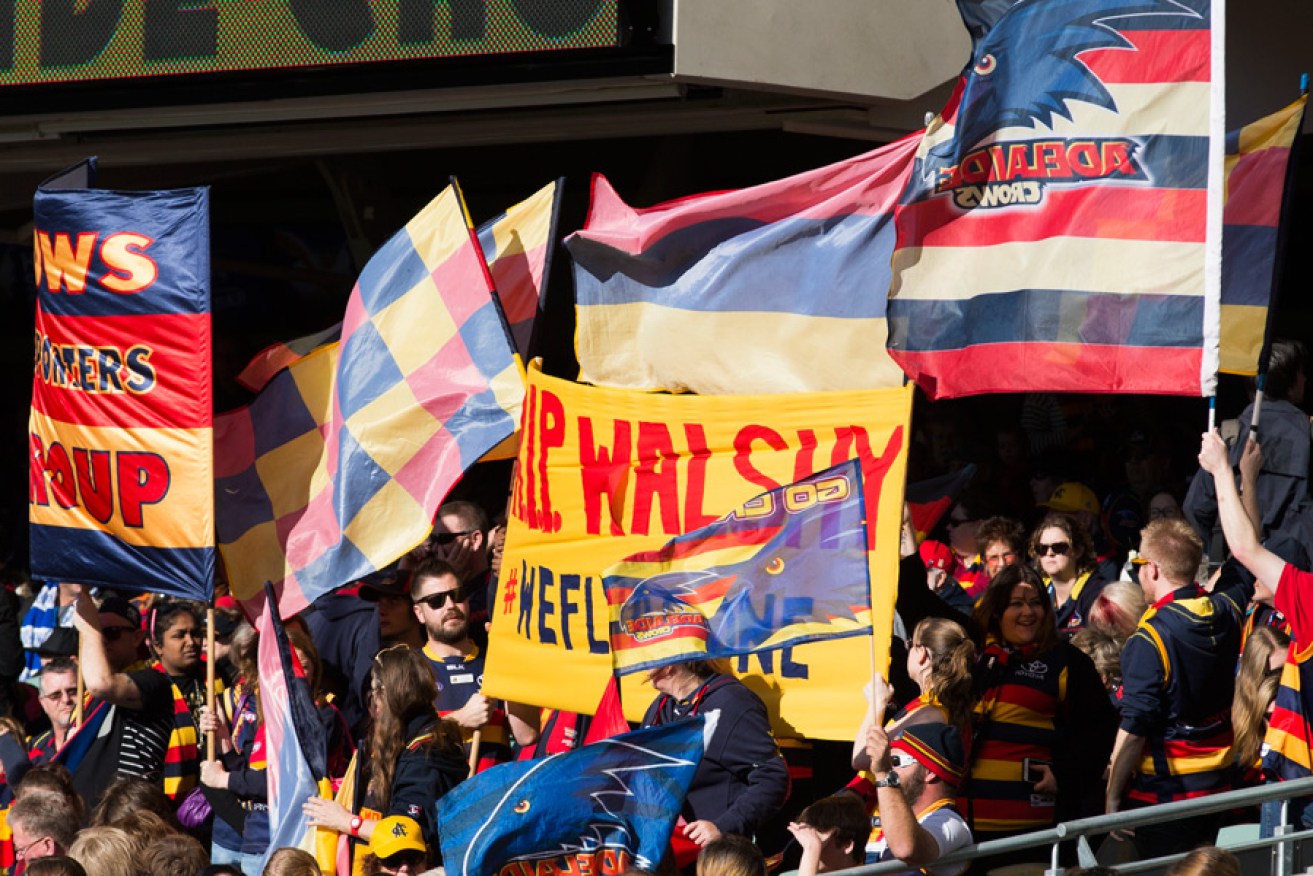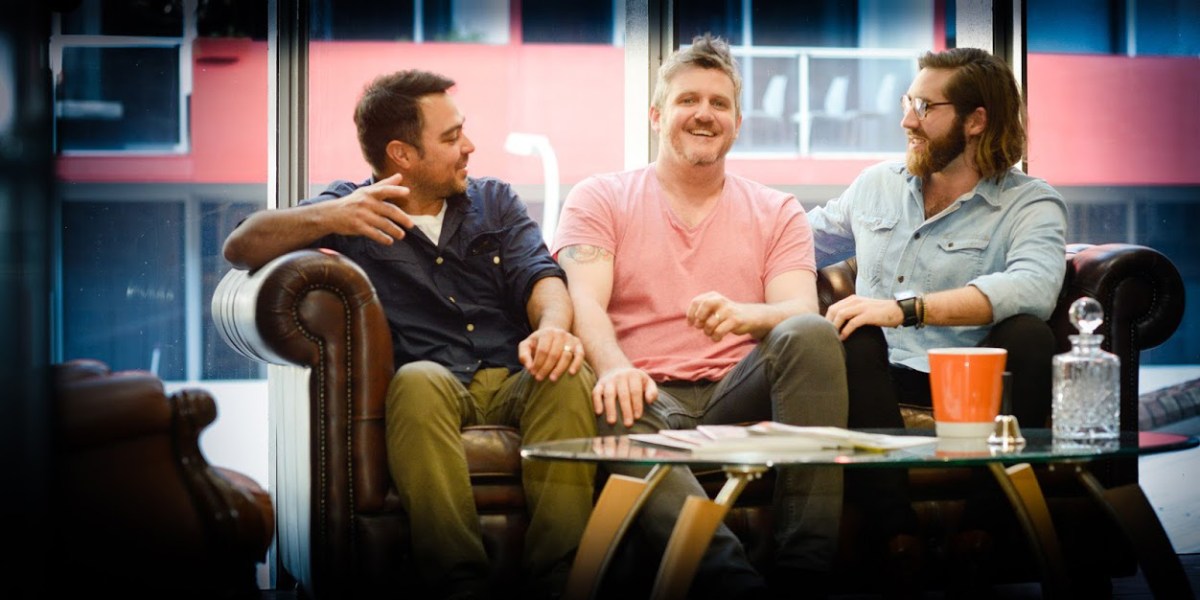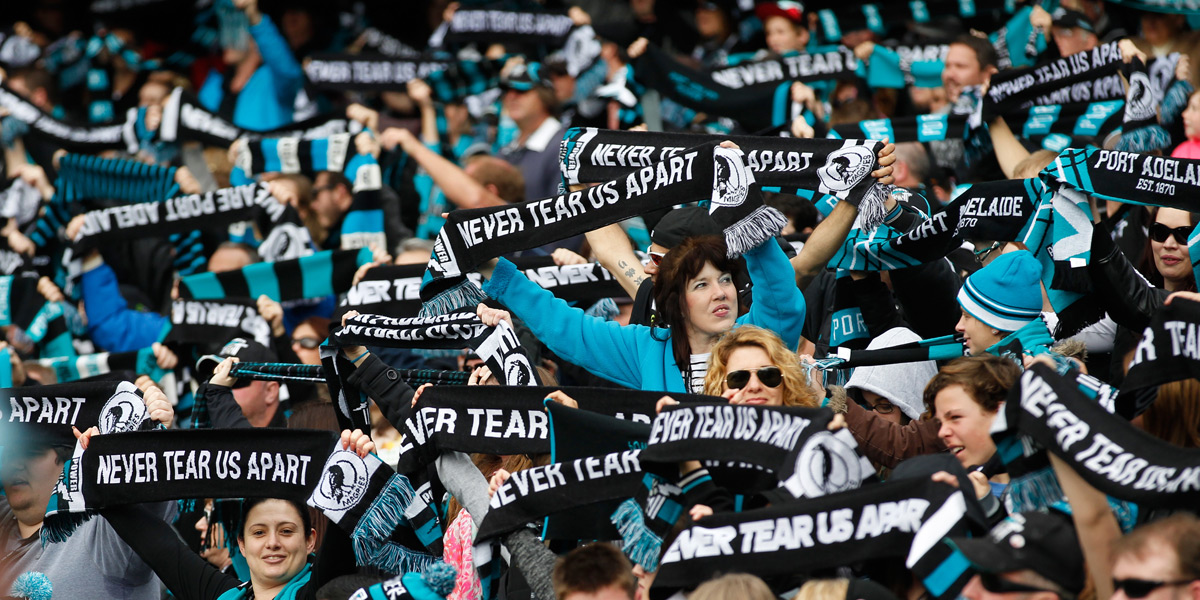Flying As One: How tragedy forged a marketing phenomenon

Crows supporters embrace the club's slogan at an Adelaide Oval memorial for slain coach Phil Walsh on July 5.
Looking back, the first time Greg Kavanagh saw the slogan he’d helped devise for the Adelaide Crows used in everyday speech was sadly ironic.
The slogan was “We Fly As One”.
The player who used it, writing about the forthcoming 2015 season, was Patrick Dangerfield, the All-Australian midfielder who will now fly, alone, to Geelong.
But it was at that moment, before the first ball was bounced on this year’s AFL season, that Kavanagh knew the phrase would catch on.
“When a brand becomes successful it becomes part of the language,” he reflects.
Kavanagh’s agency, Showpony Advertising, approached the football club late last year, having worked with Port Adelaide on strategy in the lead-up to their successful debut season at Adelaide Oval.
“It was good timing more than anything,” says Kavanagh.
“Obviously (first-year CEO) Andrew Fagan had only been there for a short period of time…he and Tom Rayner (the club’s General Manager, Consumer Business) were looking around to see what was out there.
“We met and presented a set of observations from the outside looking in, as a Crows supporter, and we agreed there were some things that needed to be worked on.”
The overarching question that needed answering was: “What does this brand stand for?”
“Over the years the club had run with a number of slogans – ‘The Pride of South Australia’, ‘The Team for All South Australians’, ‘The 19th Man’ – that were more jargonny sloganeering without any meaning behind them,” declares Kavanagh.
For him, superseding those efforts meant finding “the heart of the club”: “What’s this club about? What role does it play in people’s lives?”

Showpony Group Account Director Greg Kavanagh (centre) with senior art director Jonathan Pagano and copywriter Nic Maumill. Photo: Nat Rogers, InDaily.
The agency began a “brand methodology process”, a three-hour workshop with the Crows leadership team that “really focussed on the brand in terms of what are the ideals … what does the organisation want to be famous for?”
“And ultimately, what’s the purpose of this brand … why does it matter that it exists? If the organisation closed down tomorrow, who would care and why would they care?”
Kavanagh says Showpony doesn’t subscribe to the notion that people have deep personal bonds with brands: “We’re not a company that spouts that bullshit!”
But football clubs are a different proposition.
“When it comes to football clubs, people really, really love their club,” he says. A love that persists through good times and bad; and Adelaide had endured its share of bad times, most prominently with hefty sanctions imposed for improper payments to departed forward Kurt Tippett and the ruthless surprise sacking of coach Brenton Sanderson.
“It’s not some corporate wanker drinking a few red wines and throwing up a few ideas…”
“A few issues had tarnished their image (so) they had an image problem, but also an identification problem,” recalls Kavanagh.
“They were hit from outside with a series of issues, but they also kept changing their identity.”
The importance of a sporting brand is such that a club shouldn’t need to live and die by its on field performance, Kavanagh believes. He cites Canadian baseball team the Toronto Blue Jays, whose brand endures and thrives despite the fact they haven’t made the playoffs for more than two decades – the longest drought in the major league.
“Onfield success is obviously the most important thing, but in a competitive environment you might only win a premiership every 20 years,” explains Kavanagh.
“If it was just about that, ultimately you fail.”
The Crows’ newly-appointed first-year coach Phil Walsh was part of the Showpony workshop, and the final product embodied the “core values” he hoped to impart to his charges, mantras the public has heard incessantly parroted through the ensuing year, “Team first.” “High performance.” “Authenticity.” “Courage.”
The last one was to be a major focus, both on and off the field.
“You can make mistakes as long as you learn from them,” says Kavanagh, explaining that the club wanted to embrace “bold decisions”.
“A lot of the time you win as a result of those bold decisions.”
In the end, the mission statement boiled down to: “Bringing people together to achieve great things”.
“It was a very simple articulation of what this brand is, what we stand for and what it means,” Kavanagh says.
“And ‘We Fly As One’ was the public articulation of ‘we bring people together to achieve great things’.”
At the time, Kavanagh cited a Swedish proverb to emphasise the communal nature of the club’s brand: “Shared joy is a double joy; shared sorrow is half a sorrow.”
“Who would have known three or four months later how prophetic that would be,” he ruefully reflects.
Because, on July 3, the Crows’ first-year coach Phil Walsh was stabbed to death.
And “We Fly As One” became the rallying cry of a community bound together by sorrow.
***
If the Crows’ new approach to marketing its brand had a sense of urgency, it was derived from the resurgent success of cross-town rival Port Adelaide.
In their first season at the rebuilt Adelaide Oval, the Power had thrived on-field while the Crows had floundered, but it was off-field that Port was really forging a reputation as a pace-setter.
Its pre-game rituals had quickly progressed from fodder for industry scuttlebutt to the stuff of marketing legend, most notably a curious phenomenon that occurred just before the first ball was bounced at every home game.
The Power faithful would stand as one, scarves aloft, and sing in relative unison as the stadium speakers blared an old INXS ballad:
“I, I was standing,
You were there,
Two worlds collided,
And they could never, ever tear us apart.”
Port Adelaide’s CEO Keith Thomas told a business gathering last week that the inspiration stemmed from a post-season pilgrimage to English soccer giant Liverpool’s home ground, where the home crowd famously chants “You’ll Never Walk Alone”, an old Rodgers and Hammerstein show tune later made famous by Gerry and the Pacemakers in the 1960s.
“I think it was a bit of a collaboration to be honest,” Thomas recalls.
“We as a team went to Anfield in 2012, and the players came out of that experience thinking it would be fantastic to come up with a similar song to get to Adelaide Oval.
“And that was really fraught with danger because you could really stuff it up.”
The club “spent the best part of two years mulling this over”, but it wasn’t until February 2014 that inspiration struck again.
Channels 7 and 9 were going head to head with respective high-profile biopics; the former had heavily promoted “INXS: Never Tear Us Apart”, a docudrama about the life of the Aussie rock band and its doomed singer Michael Hutchence, while the latter wanted to cash in on the release of convicted Bali drug smuggler Schapelle Corby with a mini-series about her ordeal.
Channel 7 won the ratings battle by a mile, its special going on to become a mini-cultural phenomenon, with long-forgotten INXS albums re-entering the biggest sellers lists.
The theme of Never Tear Us Apart resonated with Port, which had recently reconciled its long-divided AFL and SANFL administrations.
“The song came up, and we were really focussed on this concept of unity,” says Thomas.
“We’d come through this division as a club… Never Tear Us Apart was suggested and we took it on.”
But not without some trepidation.
“The thing about it is, if you try to force that on your community it can go one of two ways: they’ll either embrace it, or not,” he says.
The club decided: “We’re not going to force it… we’ll give it four weeks and if no-one responds to it, we’ll get it out of there”.
But they did respond. Overwhelmingly. The song is now a permanent fixture, with supporters eagerly awaiting the chance to burst into full voice.
“What it’s created is a sense of ownership,” says Thomas.
“Our supporters own that moment, and it makes it even more powerful.”
And, as an added bonus, it left the Crows flailing to create an identity to compare with its bitter rival.
“The reason ‘Never Tear Us Apart’ worked for Port was because they were split into two clubs, and they came back together,” observes Kavanagh.
“These things work when there’s an element of truth in them.”
A fact that the Crows were to discover in the darkest of circumstances.
***
It is safe to mark the moment that “We Fly As One” transformed from a successful marketing gimmick to a statement of faith: it came as a 20,000-strong crowd gathered at Adelaide Oval for a match that never took place. The faithful arrived at the time allotted for the abandoned Round 14 Adelaide-Geelong match to pay tribute to the slain Phil Walsh.
“The tragedy happened in the middle of the year and all of a sudden the tagline took a whole new meaning,” recalls Kavanagh.
“As a club, as a community we had enjoyed success together but we held each other up during the tough times… It’s the heart and soul of what those words were intended to mean anyway.”
“After what’s happened it could be very much a permanent part of what the club stands for.”
He says Andrew Fagan believes it is now the most well-known sporting tagline in Australian sport, “and I think he’s probably right”.
“I’d say from the early days people felt like it wasn’t just a cheap slogan; there was legitimacy in it,” he argues.
“It very much was positioned to be a long-term brand line (and) I’d expect now We Fly As One would be around for five years, minimum … after what’s happened this year it could be very much a permanent part of what the club stands for.”
It is, he believes, a brand position people can identify with, “whether they be staff, players or supporters”, with tens of thousands of tags on social media reflecting its widespread appeal.
“People are just using it,” he says.
“When you come up with a line like that, it’s not some corporate wanker drinking a few red wines and throwing up a few ideas.
“We know it’s going to be right because the corporation is actually philosophically behind it … they’re in the elite sports entertainment business now and these are the values they are leading and applying through the organisation.”
He scoffed at the notion that Adelaide needed to find a musical anthem, to emulate Port’s INXS success.
He says that would transgress the core value of authenticity; being authentic means you don’t follow in another’s wake.
“One could argue that was one of the failings of the ’19th Man’ – that it was not authentic,” he says.
That conceit, which saw the club “retire” the Number 19 guernsey and instead dedicate it to its fans, who would become its “19th man” on match days, still lingers on but “I think within the organisation now it’s pretty well understood that that (refers only to) the membership”.
“But if you look at the Adelaide Football Club brand, it’s all about We Fly As One.”
The club “100 per cent” owns the intellectual property to the tagline – “they commissioned that work and paid for it, so it’s theirs” – but Kavanagh is hopeful of an ongoing business relationship, and is already gearing up to prepare a 2016 campaign.
The flavour of that will likely be dictated, to some extent, by the values and whims of whomever the Crows appoint to take their coaching reins in the coming weeks. But the themes of solidarity, authenticity and courage are likely to persist, a lingering tribute to Phil Walsh, whose death united the Crows community like never before.





